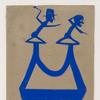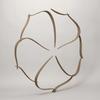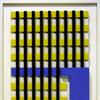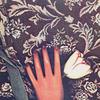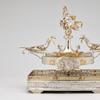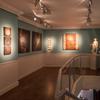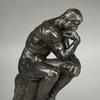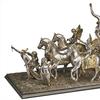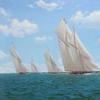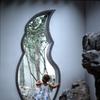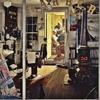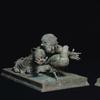From Space Travel to Augmented Reality, Crystal Bridges Looks for New Ways to Innovate
- BENTONVILLE, Arkansas
- /
- January 23, 2019
Crystal Bridges Museum of American Art launched an artwork into space via a weather balloon at a public Art in Space event on Sunday, January 20 as a celebration of art, space, and the upcoming exhibition Men of Steel, Women of Wonder.
“Sending art into space may seem a bit unusual, but in the context of our mission to provide access, education, and community engagement, it totally fits,” said Shane Richey, creative director of experimentation and development at Crystal Bridges. “While we show hundreds of artworks in our galleries and on our grounds, this was the first time Crystal Bridges has sent an artwork away from the earth, and we were excited to share the experience and learnings with the community, both on-site and through various new media platforms.”
The inspiration to launch an artwork in to space came from the museum’s upcoming temporary exhibition, Men of Steel, Women of Wonder, which examines art-world responses to Superman and Wonder Woman. The exhibition was developed at Crystal Bridges by Assistant Curator Alejo Benedetti and features over 70 paintings, photographs, installations, videos, and more by over 50 artists. Men of Steel, Women of Wonder will open to the public on February 9.
“As we all know, Superman is from another planet, but crash-landed on Earth,” said Benedetti. “This seemed like a particularly fun opportunity to capture that concept, highlight an artist’s work, and do something new and exciting all at the same time. Artist Robert Pruitt’s work features futuristic themes, and I immediately thought of him for this project.”
Pruitt’s sculpture (Untitled male figure, 2019) was created specifically for this event. The artwork weighed under 3 lb. with a dimension of 24 1/4” x 12” x 5 1/2”. Two of Pruitt’s other artworks will also be featured in Men of Steel, Women of Wonder: Heliocentrist (2013, conte, gold leaf, coffee) and SUP (2018, conte charcoal on coffee stained paper).
“The sculpture is a male Dogon figure that I have altered slightly, adding a covering of aluminum foil, an antennae, and a suitcase containing a secret package to be delivered to space,” said Pruitt. “The Dogon are a people and culture from Mali who have a long relationship with stargazing.”
Pruitt works in a variety of materials but his practice is largely centered on rendering portraits of the human body, specifically the black body. He projects a juxtaposing series of experiences and material references onto these bodies, denoting a diverse and radical black past, present, and future.
“One of the reoccurring elements in this universe is the idea of space travel as a mode of escape, and as an exploration of the unknown,” said Pruitt. “This project is, for me, an exciting opportunity to reflect these ideas in a much more literal sense.”
At the event, Pruitt, along with Houston-based artist Maurice Duhon Jr. conducted a performance art piece to commemorate the launch. A music composition, composed by JAWWAAD Taylor, accompanied the launch as the balloon lifted off. Visitors enjoyed hot cocoa and activities with Crystal Bridges and the Amazeum as they awaited the launch.
Dr. Ross Carroll, an associate professor of physics at Arkansas State University, has been accompanying the project as an advisor. Carroll has launched high altitude balloons with the Arkansas BalloonSAT group since 2016.
The 12-foot balloon was attached to a custom built protective frame built by Amazeum Making and Tinkering Manager Joel Gordon and equipped with an MP3 unit, 2 GoPro cameras, and a GPS tracker, all attached to a protective rigid foam frame that protected the sculpture and electronics during the journey.
To recover the aircraft, Richey and Benedetti watched the GPS tracker until they noticed that the coordinates stopped moving. The aircraft traveled southeast to the Ozark National Forest, near Hector, Ark., and north of Russellville, reaching 109,000 feet at its peak and spending a total of one hour and 35 minutes in the air from launch to landing. After a few hours of wandering through the woods, they found it hanging safely on a tree limb. The music composition was still playing when it was retrieved.
Post-journey, the balloon and the artwork have returned to Crystal Bridges and will be on display in the Reflection Area (located off the Great Hall Corridor) at the museum while Men of Steel, Women of Wonder is on view.
Experimentation at Crystal Bridges
In addition to sending an artwork into space, over the past year, Crystal Bridges has also launched several other experimental technology projects including virtual reality, augmented reality, an audio immersion project, and a low-technology experimentation space called the Niche.
- Virtual Reality – The museum unveiled the Crystal Bridges Virtual Reality (CBVR) program last March when the Early American Art Galleries were re-installed. This project took hold during a time when a beloved artwork, Kindred Spirits by Asher B. Durand, was on loan traveling to other venues. Visitors began asking about it, and to find a solution while remaining stewards in the art community, Crystal Bridges began pursuing virtual reality technology as a way for visitors to interact with the painting in a digitally immersive way. The CBVR headsets, which are for sale in the Museum Store, put the viewer inside the painting for a deeper art experience.
- Augmented Reality – In 2018, augmented technology was used in the focus exhibition In Conversation: Will Wilson and Edward Curtis (on view until February 2019) with the help of technology from Layar. With this technology, a gallery viewer could hold his or her phone up to select photographs in the exhibition and the subjects would come to life and talk. These “surprise and delight” moments are received well by visitors and allow them to engage with artworks on a deeper dimension. Crystal Bridges is developing and testing AR Architecture, an augmented reality tour of the museum’s architecture that visitors will be able to access with their phones.
- Audio Immersion Prototype – After receiving a grant from the Knight Foundation Prototype Fund, Richey pursued an audio immersion prototype which will be beta-tested during Men of Steel, Women of Wonder. The prototype consists of a pair of specially designed headphones connected to a pocket-sized device which plays audio that immerses the gallery viewer in the world of whichever artwork he or she chooses. The prototype will not be available for public access, but if successful in this trial run, Crystal Bridges will be able to provide new audio-based interpretations that will allow visitors to interact with fresh content and indulge a new sense in the galleries.
- The Niche – The Niche is an aptly named corner of the museum’s Early American Art Gallery where Crystal Bridges staff members have complete control over the content and themes presented in the space. The purpose of the Niche’s creation was to give staff members a space to be creative and innovate new ideas borne out of personal passions at the museum. The content in this corner changes every month to demonstrate the consistent churn of new ideas being explored at the museum. In 2018, the space featured everything from a gallery murder-mystery, to an interactive Spanglish game, to a self-portrait station, and more.
“Crystal Bridges is interested in the convergence of art and innovation, but there’s a balance to be found when using experimentation to add value to our purpose,” said Richey. “The goal is not technology for technology’s sake, but looking for new tools that we can use to bring the public closer to art. Whether we’re developing a 105-square-foot space for experimentation or sending art into space, it’s always an adventure.”


